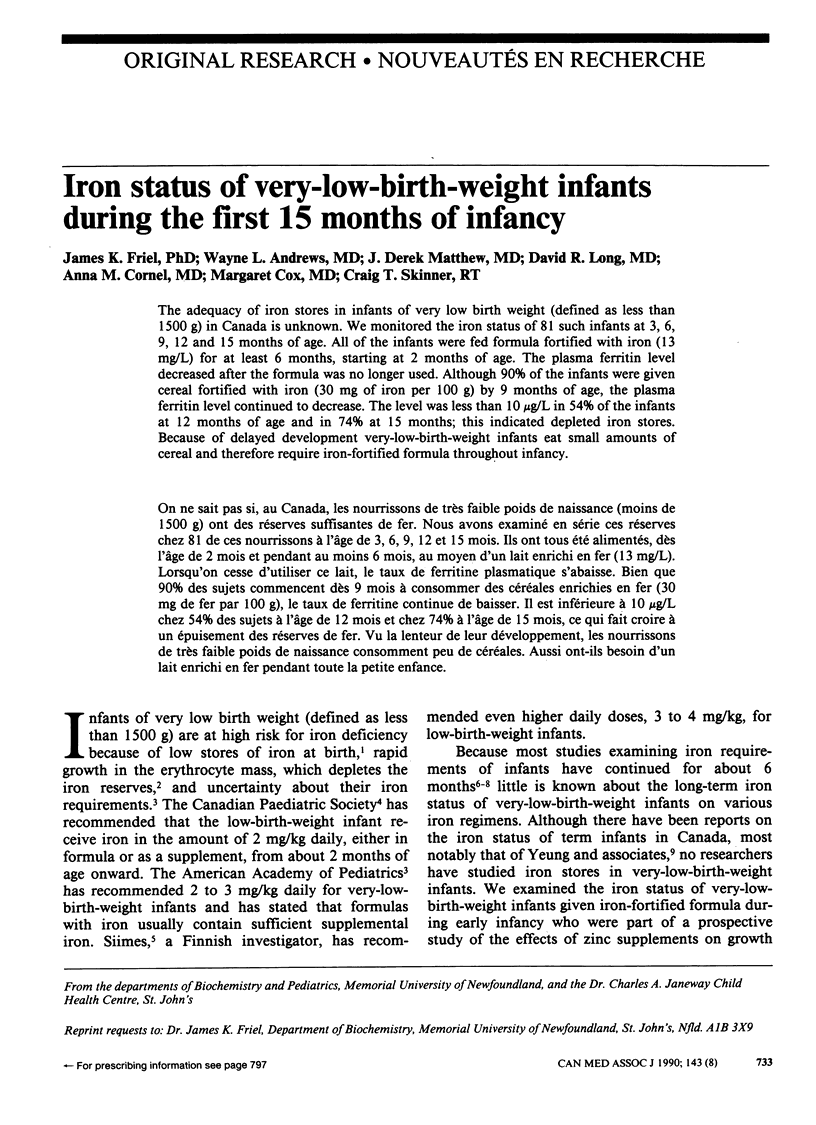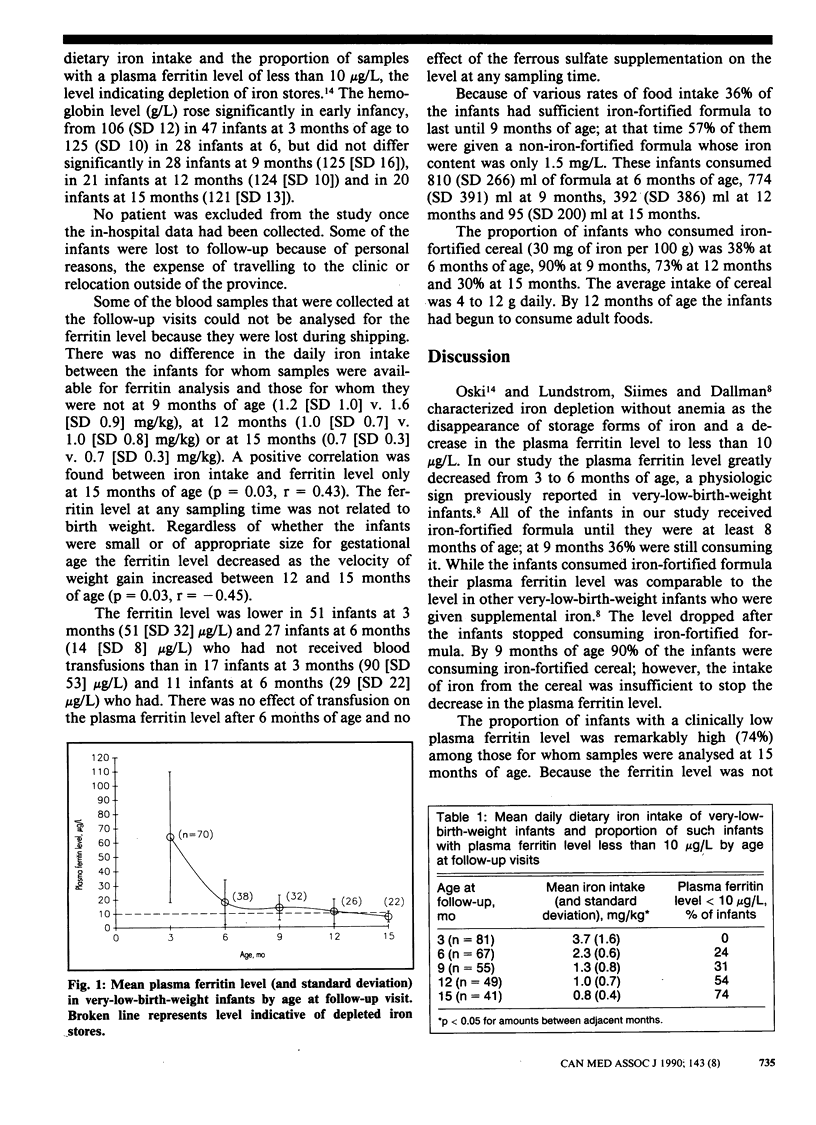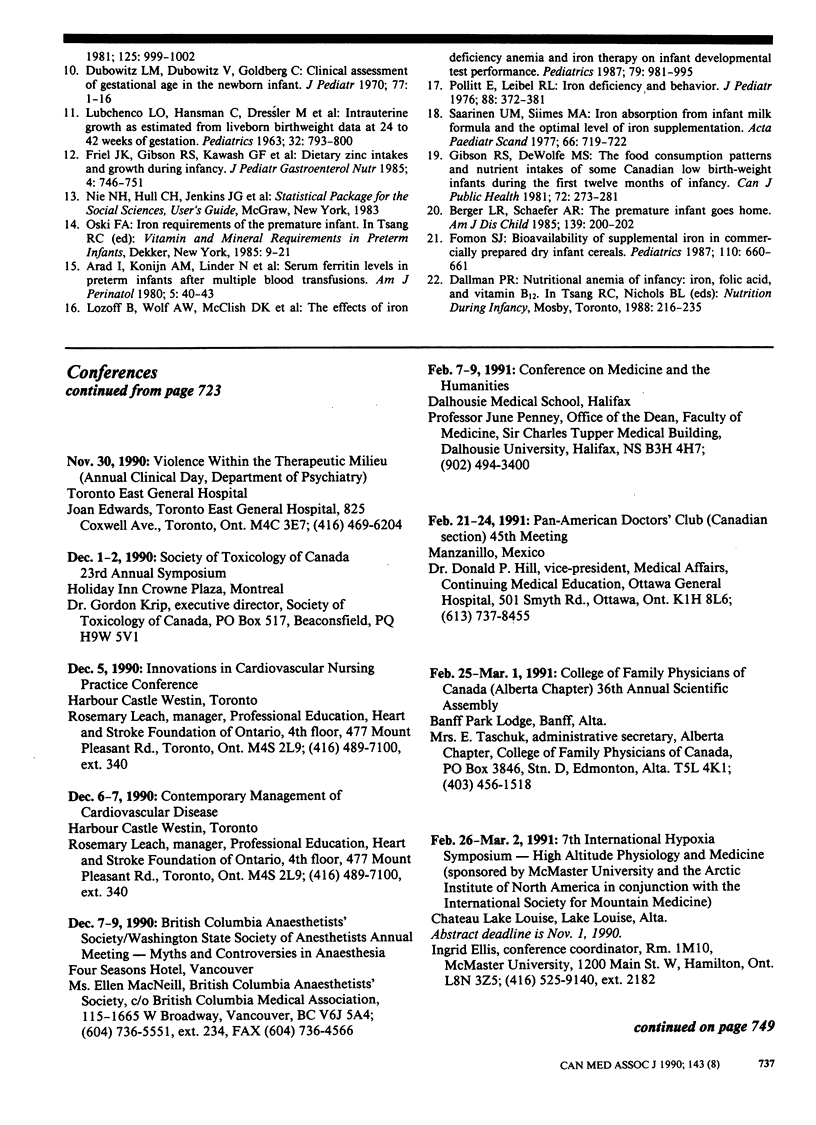Abstract
The adequacy of iron stores in infants of very low birth weight (defined as less than 1500 g) in Canada is unknown. We monitored the iron status of 81 such infants at 3, 6, 9, 12 and 15 months of age. All of the infants were fed formula fortified with iron (13 mg/L) for at least 6 months, starting at 2 months of age. The plasma ferritin level decreased after the formula was no longer used. Although 90% of the infants were given cereal fortified with iron (30 mg of iron per 100 g) by 9 months of age, the plasma ferritin level continued to decrease. The level was less than 10 micrograms/L in 54% of the infants at 12 months of age and in 74% at 15 months; this indicated depleted iron stores. Because of delayed development very-low-birth-weight infants eat small amounts of cereal and therefore require iron-fortified formula throughout infancy.
Full text
PDF




Selected References
These references are in PubMed. This may not be the complete list of references from this article.
- Arad I., Konijn A. M., Linder N., Goldstein M., Kaufmann N. A. Serum ferritin levels in preterm infants after multiple blood transfusions. Am J Perinatol. 1988 Jan;5(1):40–43. doi: 10.1055/s-2007-999651. [DOI] [PubMed] [Google Scholar]
- Berger L. R., Schaefer A. R. The premature infant goes home. Guidelines for primary care. Am J Dis Child. 1985 Feb;139(2):200–202. doi: 10.1001/archpedi.1985.02140040102039. [DOI] [PubMed] [Google Scholar]
- Dubowitz L. M., Dubowitz V., Goldberg C. Clinical assessment of gestational age in the newborn infant. J Pediatr. 1970 Jul;77(1):1–10. doi: 10.1016/s0022-3476(70)80038-5. [DOI] [PubMed] [Google Scholar]
- Fomon S. J. Bioavailability of supplemental iron in commercially prepared dry infant cereals. J Pediatr. 1987 Apr;110(4):660–661. doi: 10.1016/s0022-3476(87)80575-9. [DOI] [PubMed] [Google Scholar]
- Friel J. K., Gibson R. S., Kawash G. F., Watts J. Dietary zinc intake and growth during infancy. J Pediatr Gastroenterol Nutr. 1985 Oct;4(5):746–751. doi: 10.1097/00005176-198510000-00011. [DOI] [PubMed] [Google Scholar]
- GORTEN M. K., CROSS E. R. IRON METABOLISM IN PREMATURE INFANTS. II. PREVENTION OF IRON DEFICIENCY. J Pediatr. 1964 Apr;64:509–520. doi: 10.1016/s0022-3476(64)80340-1. [DOI] [PubMed] [Google Scholar]
- Gibson R. S., DeWolfe M. S. The food consumption patterns and nutrient intakes of some Canadian low birth-weight infants during the first twelve months of infancy. Can J Public Health. 1981 Jul-Aug;72(4):273–281. [PubMed] [Google Scholar]
- Iwai Y., Takanashi T., Nakao Y., Mikawa H. Iron status in low birth weight infants on breast and formula feeding. Eur J Pediatr. 1986 Apr;145(1-2):63–65. doi: 10.1007/BF00441856. [DOI] [PubMed] [Google Scholar]
- Jansson L., Holmberg L., Ekman R. Medicinal iron to low birth weight infants. Acta Paediatr Scand. 1979 Sep;68(5):705–708. doi: 10.1111/j.1651-2227.1979.tb18442.x. [DOI] [PubMed] [Google Scholar]
- LUBCHENCO L. O., HANSMAN C., DRESSLER M., BOYD E. INTRAUTERINE GROWTH AS ESTIMATED FROM LIVEBORN BIRTH-WEIGHT DATA AT 24 TO 42 WEEKS OF GESTATION. Pediatrics. 1963 Nov;32:793–800. [PubMed] [Google Scholar]
- Lozoff B., Brittenham G. M., Wolf A. W., McClish D. K., Kuhnert P. M., Jimenez E., Jimenez R., Mora L. A., Gomez I., Krauskoph D. Iron deficiency anemia and iron therapy effects on infant developmental test performance. Pediatrics. 1987 Jun;79(6):981–995. [PubMed] [Google Scholar]
- Lundström U., Siimes M. A., Dallman P. R. At what age does iron supplementation become necessary in low-birth-weight infants? J Pediatr. 1977 Dec;91(6):878–883. doi: 10.1016/s0022-3476(77)80881-0. [DOI] [PubMed] [Google Scholar]
- Pollitt E., Leibel R. L. Iron deficiency and behavior. J Pediatr. 1976 Mar;88(3):372–381. doi: 10.1016/s0022-3476(76)80250-8. [DOI] [PubMed] [Google Scholar]
- Saarinen U. M., Siimes M. A. Iron absorption from infant milk formula and the optimal level of iron supplementation. Acta Paediatr Scand. 1977 Nov;66(6):719–722. doi: 10.1111/j.1651-2227.1977.tb07978.x. [DOI] [PubMed] [Google Scholar]
- Siimes M. A. Iron requirement in low birthweight infants. Acta Paediatr Scand Suppl. 1982;296:101–103. doi: 10.1111/j.1651-2227.1982.tb09606.x. [DOI] [PubMed] [Google Scholar]
- Worwood M. The clinical biochemistry of iron. Semin Hematol. 1977 Jan;14(1):3–30. [PubMed] [Google Scholar]
- Yeung D. L., Pennell M. D., Leung M., Hall J., Anderson G. H. Iron intake of infants: the importance of infant cereals. Can Med Assoc J. 1981 Nov 1;125(9):999–1002. [PMC free article] [PubMed] [Google Scholar]


